 A
A
HOMEOPATHIC
HANDBOOK
OF
NATURAL
REMEDIES ____ 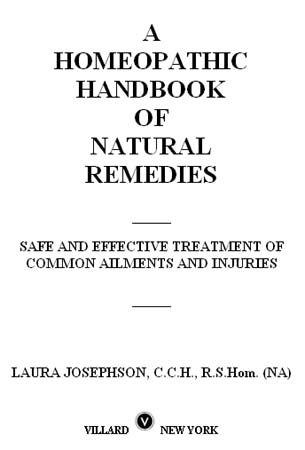 Dedicated to all the wise healers through the ages who have helped to illuminate for us the healing art and science of homeopathy; to todays homeopaths and those of the future who strive to carry the flame onward, lighting the way for generations to come. And in remembrance of those who perished on September 11, 2001: Now that weve been shaken by death and destructionLet us take the crude poisonAnd potentize it as a healing forceLet us breathe deeply the ashen airAnd exhale it as sweet incenseSo that love of neighbor and trust in GodMay reign upon the earthLaura JosephsonNew YorkOctober 9, 2001 ACKNOWLEDGMENTS Many people have helped with the writing of this book. I would first like to thank my husband, David, and our four daughters for their immeasurable patience, love, and support, which enabled me to complete this project. To them I am deeply grateful. I wish to thank Mary Bahr and Kathy Rosenbloom at Random House for their enthusiasm for this project. This book would not have been written without their interest and encouragement.
Dedicated to all the wise healers through the ages who have helped to illuminate for us the healing art and science of homeopathy; to todays homeopaths and those of the future who strive to carry the flame onward, lighting the way for generations to come. And in remembrance of those who perished on September 11, 2001: Now that weve been shaken by death and destructionLet us take the crude poisonAnd potentize it as a healing forceLet us breathe deeply the ashen airAnd exhale it as sweet incenseSo that love of neighbor and trust in GodMay reign upon the earthLaura JosephsonNew YorkOctober 9, 2001 ACKNOWLEDGMENTS Many people have helped with the writing of this book. I would first like to thank my husband, David, and our four daughters for their immeasurable patience, love, and support, which enabled me to complete this project. To them I am deeply grateful. I wish to thank Mary Bahr and Kathy Rosenbloom at Random House for their enthusiasm for this project. This book would not have been written without their interest and encouragement.
Special thanks are due to Sue Anello, C.C.H., and Jane Shepard, M.Ed., whose homeopathic knowledge, expertise, and friendship have been immensely helpful in gathering information and editing significant portions of the text. My thanks also go to Estelle Delaunay and Danel Cove for their generous assistance and to many of my colleagues, dear friends, and family for their helpful feedback and kind wishes. My gratitude goes as well to all the patients who have sought my help over the last ten years, whose trust and openness have been invaluable gifts. They have taught me much. Last but not least, my heartfelt thanks go to the many devoted teachers in homeopathy and other fields, both living and departed, whose lives and work have inspired my own learning and love of homeopathy. Their dedication and courage to seek truth, wholeness, and healing continue to guide my daily steps.
CONTENTS INTRODUCTION The highest ideal of cure is the rapid, gentle, and permanent restoration of health; the removal and annihilation of the whole disease by the shortest, most reliable, and least harmful way, according to clearly comprehensible principles. Samuel Hahnemann, Organon,
6th edition For as long as mankind has inhabited the earth, human beings have suffered afflictions and have sought healing. Remedies for our ills have been found by looking toward the natural world around us. The earth and its minerals, its waters, many plants, insects, and animals, and even the starry heavens have given humankind a rich array of tools through which we have learned diverse healing arts. Throughout evolution and up to the present day, we continue to blaze a trail through time, seeking to penetrate these very tools with human understanding, wisdom, and compassion. Today that trail leads us on many divergent paths, some intersecting, some never to meet. Among these different roads, the widest and most traveled in the United States is the current conventional medical system.
Much like an overcrowded airport terminal, this system is often congested, ineffectual, and overpriced; travelers often experience side effects, feel anonymous, and arrive at their destinations bewildered and exhausted. On the journey to good health, more people today are in search of alternative routes that better meet their needs. In fact, these routes are rapidly widening as Americans beat a path to alternative and complementary medicine in increasing numbers. Today nearly half of all Americans use at least one alternative form of therapy. Many people are looking for a healing method that respects and honors the inherent wisdom of the body and the individuality of each person, that stimulates the bodys natural ability to heal itself, that utilizes powerful yet gentle natural remedies which produce no toxic side effects; in short, a healing system that understands true health to be an integrated wholeness of all human qualities. Homeopathy is one such wise and gentle approach.
For more than two hundred years homeopathy has helped people all over the world find solutions to their health problems. It is among the most accepted forms of natural medicine in the world today. According to the World Health Organization, homeopathy is the second most widely used system of medicine in the world and the fastest growing. It is well established in the United Kingdom, France, Germany, Russia, India, and many other countries around the world. For over a century the British royal family has preferred homeopathy to other forms of treatment, and the Queen of England retains a homeopathic physician. From minor ailments to more serious chronic diseases, homeopathy offers a sound science of healing based on a holistic view of the human being, that is, a system of care that takes the whole individual into account and does not just treat isolated symptoms.
It may be surprising to learn of the popularity that homeopathy enjoyed in the nineteenth and early twentieth centuries in the United States. Homeopathys success in Europe spread to the States in the 1830s, and by the turn of the century approximately one in five of all physicians were homeopaths. At that time more than one hundred homeopathic training colleges and twenty medical schools flourished in the United States; more than one thousand pharmacies made and supplied homeopathic medicines. Homeopathy gained wide acceptance in part through its tremendous success in treating epidemic diseases, such as yellow fever, scarlet fever, and cholera. At the same time, however, the American Medical Association (AMA) was trying to purge the profession of any physicians who practiced outside the conventional model. In fact, the AMA was founded in 1846 expressly in opposition to the increasingly popular homeopaths.
In 1855 the AMA added a stipulation to its code of ethics that any doctor who consulted with a homeopathic physician could be expelled. The AMA persisted in its aim to suppress homeopathy. It influenced state licensing boards and medical college funding committees and collaborated with the financial interests of pharmaceutical companies to disparage homeopathy. The success of these efforts was substantial: After 1910 many homeopathic medical colleges lost funding and closed down or were converted into conventional medical schools. By 1950 no homeopathic medical colleges remained in the United States, and only an estimated one hundred practitioners were left. Despite the dismal decline, homeopathy remained alive through independent homeopathic study groups, a handful of dedicated practitioners and their patients, and connections to homeopathic circles in Europe and other parts of the world.
Over the last twenty years, with a widespread recognition of the flaws and limitations of conventional medicine, and with increased public interest in natural approaches, homeopathy has undergone a worldwide renaissance as people rediscover its benefits. Because of this homeopathic remedies are inexpensive and easy to obtain; homeopathic books, articles, studies, and other resources are widely available through booksellers and the Internet; and a variety of homeopathic schools and training programs are increasingly accessible to both health care professionals and the public. The holistic approach found in homeopathy is especially relevant today. Mainstream twentieth-century medical thinking promoted a mechanistic model of the human being, in which health and illness are seen as primarily determined by the functioning of molecules, atoms, and biochemical interactions. The idea that nonphysical aspects of our makeup, such as human consciousness, are connected to physical health is an ancient concept but is relatively new in contemporary Western culture. Only in recent years has there been a heightened awareness of and interest in the mind-body connection.
Next page

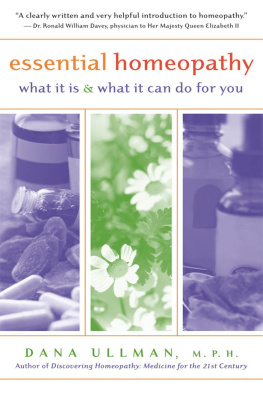
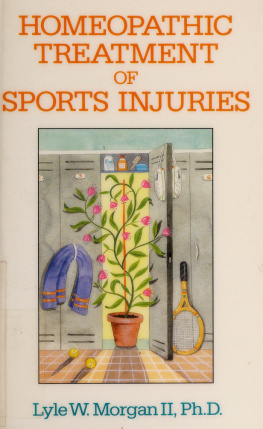
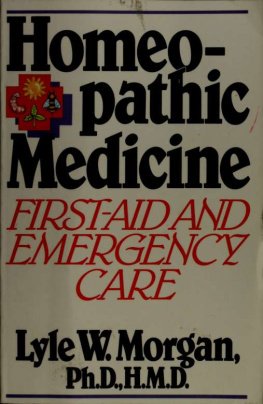
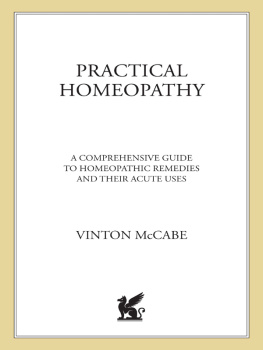
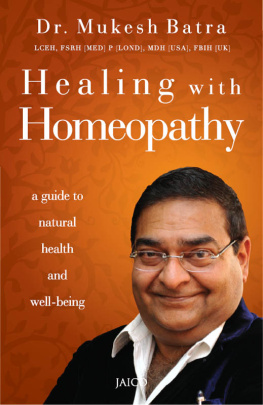
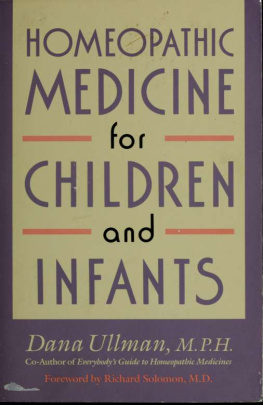
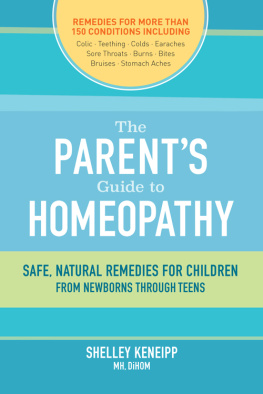
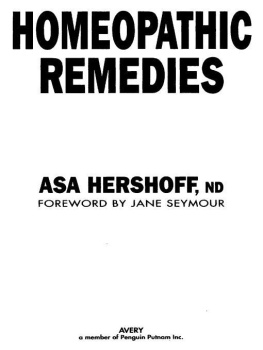
 A
A Dedicated to all the wise healers through the ages who have helped to illuminate for us the healing art and science of homeopathy; to todays homeopaths and those of the future who strive to carry the flame onward, lighting the way for generations to come. And in remembrance of those who perished on September 11, 2001: Now that weve been shaken by death and destructionLet us take the crude poisonAnd potentize it as a healing forceLet us breathe deeply the ashen airAnd exhale it as sweet incenseSo that love of neighbor and trust in GodMay reign upon the earthLaura JosephsonNew YorkOctober 9, 2001 ACKNOWLEDGMENTS Many people have helped with the writing of this book. I would first like to thank my husband, David, and our four daughters for their immeasurable patience, love, and support, which enabled me to complete this project. To them I am deeply grateful. I wish to thank Mary Bahr and Kathy Rosenbloom at Random House for their enthusiasm for this project. This book would not have been written without their interest and encouragement.
Dedicated to all the wise healers through the ages who have helped to illuminate for us the healing art and science of homeopathy; to todays homeopaths and those of the future who strive to carry the flame onward, lighting the way for generations to come. And in remembrance of those who perished on September 11, 2001: Now that weve been shaken by death and destructionLet us take the crude poisonAnd potentize it as a healing forceLet us breathe deeply the ashen airAnd exhale it as sweet incenseSo that love of neighbor and trust in GodMay reign upon the earthLaura JosephsonNew YorkOctober 9, 2001 ACKNOWLEDGMENTS Many people have helped with the writing of this book. I would first like to thank my husband, David, and our four daughters for their immeasurable patience, love, and support, which enabled me to complete this project. To them I am deeply grateful. I wish to thank Mary Bahr and Kathy Rosenbloom at Random House for their enthusiasm for this project. This book would not have been written without their interest and encouragement.